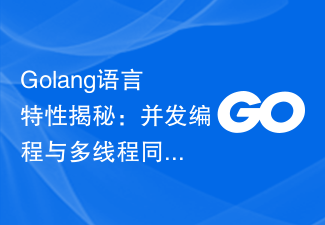 Backend Development
Backend Development Golang
Golang Learn the concurrent programming model in Go language and implement task monitoring of distributed computing?
Learn the concurrent programming model in Go language and implement task monitoring of distributed computing?Learn the concurrent programming model in Go language and implement monitoring of distributed computing tasks
Go language, as a modern, efficient and concurrency-rich programming language, provides a simple and easy-to-use concurrency Programming model can be used to solve various complex concurrency problems. In this article, we will learn how to use the concurrent programming model of the Go language to implement a monitoring system for distributed computing tasks.
First of all, we need to clarify the concept of distributed computing tasks. Distributed computing refers to decomposing a large computing problem into multiple subtasks, executing these subtasks concurrently on multiple computers, and finally merging the results to obtain the final calculation result. In this process, functions such as task distribution, execution, and result collection need to be implemented.
The following is a simple example that demonstrates how to use the concurrent programming model of the Go language to implement a monitoring system for distributed computing tasks.
First, define a structure representing the task, including the ID and status of the task:
type Task struct {
ID int
Status string
}Next, we need to implement the distribution and execution functions of the task. Suppose we have a set of tasks that need to be executed concurrently on multiple computers. We can use goroutine in the Go language to implement concurrent execution of tasks. The following example demonstrates how to use goroutine to implement task distribution and execution:
func distributeTasks(tasks []Task) {
for _, task := range tasks {
go executeTask(task)
}
}
func executeTask(task Task) {
// 执行任务的具体逻辑
// ...
task.Status = "completed"
log.Printf("Task [%d] is completed
", task.ID)
} In the above example, we use the distributeTasks function to traverse the task list and use goroutine for concurrency Execute the executeTask function. Each executeTask function represents the execution logic of a subtask. After executing the task, the task status is updated and the log is recorded.
Finally, we need to implement the collection and monitoring functions of results. Channels can be used to collect and monitor results. The following example demonstrates how to use channel to collect and monitor results:
func monitorTasks(tasks []Task) {
results := make(chan Task)
go collectResults(results)
for _, task := range tasks {
go func(task Task) {
// 执行任务的具体逻辑
// ...
task.Status = "completed"
results <- task
}(task)
}
}
func collectResults(results chan Task) {
for task := range results {
log.Printf("Task [%d] is completed
", task.ID)
}
}In the above example, we used resultschannel to collect the execution results of the task. Create a goroutine to monitor the collection of results by calling the collectResults function. The execution logic of the task is completed in the anonymous function, and the task results are sent to the resultschannel.
Through the above examples, we can see that in the Go language, by using goroutine and channel, we can easily implement a monitoring system for distributed computing tasks. In practical applications, this system can be further improved and expanded according to actual needs, such as increasing task priority, task retry mechanism, etc.
To sum up, using the concurrent programming model of Go language can easily implement a monitoring system for distributed computing tasks. By using goroutine and channels, we can execute tasks concurrently, collect task execution results, and monitor and process the results. This concurrent programming model enables us to fully utilize the performance of multi-core computers and simplifies the programming implementation of distributed computing tasks.
The above is the detailed content of Learn the concurrent programming model in Go language and implement task monitoring of distributed computing?. For more information, please follow other related articles on the PHP Chinese website!
 如何在PHP中使用多线程编程?May 12, 2023 am 08:39 AM
如何在PHP中使用多线程编程?May 12, 2023 am 08:39 AM随着Web应用程序变得越来越庞大和复杂,传统的单线程PHP开发模式不再适用于高并发处理。在这种情况下,使用多线程技术可以提高Web应用程序处理并发请求的能力。本文将介绍如何在PHP中使用多线程编程。一、多线程概述多线程编程是指在一个进程中并发执行多个线程,每个线程都能单独访问进程中的共享内存和资源。多线程技术可以提高CPU和内存的使用效率,同时可以处理更多的
 Golang语言特性揭秘:并发编程与多线程同步Jul 17, 2023 am 09:48 AM
Golang语言特性揭秘:并发编程与多线程同步Jul 17, 2023 am 09:48 AMGolang语言特性揭秘:并发编程与多线程同步Golang是一种现代化的编程语言,被设计用于解决大规模并发问题。它的并发编程模型让开发人员可以轻松地创建并管理多个goroutine,实现高效的并发执行。在本文中,我们将揭秘Golang的并发编程特性,并探讨如何在多线程中进行同步。Golang的并发编程模型基于goroutine和channel。gorouti
 Java线程池的并发编程技巧与应用实践Jun 15, 2023 pm 11:25 PM
Java线程池的并发编程技巧与应用实践Jun 15, 2023 pm 11:25 PMJava线程池的并发编程技巧与应用实践随着互联网和移动互联网的普及,并发访问量变得越来越大,传统单线程编程方式已经无法满足大规模并发的需求。Java线程池充分利用CPU资源,实现高效并发编程,是面向对象编程中不可或缺的一部分。本文从Java线程池的基本原理入手,介绍了线程池的核心参数配置、使用方法、线程池的应用场景及其优化策略。一、Java线程池基本原理J
 如何利用 Go 语言进行并发编程?Jun 10, 2023 am 10:33 AM
如何利用 Go 语言进行并发编程?Jun 10, 2023 am 10:33 AM随着计算机硬件的不断发展,处理器中的CPU核心不再单独增加时钟频率,而是增加核心数量。这引发了一个显而易见的问题:如何发挥这些核心的性能?一种解决方法是通过并行编程,即同时执行多个任务,以充分利用CPU核心。这就是Go语言的一个独特之处,它是一门专为并发编程而设计的语言。在本文中,我们将探讨如何利用Go语言进行并发编程。协程首先,我们需要了解
 PHP中的并行编程技术May 23, 2023 pm 07:21 PM
PHP中的并行编程技术May 23, 2023 pm 07:21 PM随着互联网的快速发展,大型Web应用程序的开发变得越来越流行。在这种情况下,一个Web应用程序需要处理来自数百甚至数千个用户的请求。这就需要并行编程技术,以便在处理多个请求时提高程序的性能。PHP是一个流行的脚本语言,广泛用于Web应用程序的开发。PHP提供了多种并行编程技术,包括多进程、多线程和异步编程。在本文中,我们会介绍这些技术,以及它们如何帮助我们实
 如何使用PHP7.0进行并发编程?May 28, 2023 am 08:51 AM
如何使用PHP7.0进行并发编程?May 28, 2023 am 08:51 AMPHP7.0是当前最常用的服务器端编程语言之一。它界面友好、易于学习,功能强大,具有丰富的扩展库。在并发编程方面,PHP7.0也有许多优秀的工具和技术。本文将介绍如何在PHP7.0中进行并发编程。一、什么是并发编程并发编程是指通过多个线程,进程或协程等方式,使多个任务在同一时间内同时执行的编程方式。在编程中,有效地使用并发技术可以提高程序的性能和吞吐量。二、
 Golang并发编程探索之Goroutines的线程模型详解Jul 17, 2023 pm 10:24 PM
Golang并发编程探索之Goroutines的线程模型详解Jul 17, 2023 pm 10:24 PMGolang并发编程探索之Goroutines的线程模型详解在当今互联网时代,高并发成为了各种系统开发中非常重要的一个课题。传统的单线程编程模型很难以满足大量并发请求的需求,而在很多编程语言中,多线程编程也存在着复杂的竞态条件、死锁等问题。而在Golang中,通过轻量级的Goroutines和基于通信的并发模型,使得并发编程变得更加简单和高效。Gorouti
 Java 中的并发编程框架Jun 08, 2023 pm 12:31 PM
Java 中的并发编程框架Jun 08, 2023 pm 12:31 PM随着计算机科技不断发展,多核CPU成为主流,并行和并发已经成为开发领域中的热点话题。Java中的并发编程框架也逐渐地成为了Java开发中的重要组成部分,解决了很多并发编程问题。本文将介绍Java中的并发编程框架以及如何使用这些框架提高程序的性能和可伸缩性。Java中的并发编程Java是一门面向对象的编程语言,最初是面向单线程的。但是在Java5版本中引入


Hot AI Tools

Undresser.AI Undress
AI-powered app for creating realistic nude photos

AI Clothes Remover
Online AI tool for removing clothes from photos.

Undress AI Tool
Undress images for free

Clothoff.io
AI clothes remover

AI Hentai Generator
Generate AI Hentai for free.

Hot Article

Hot Tools

SublimeText3 Mac version
God-level code editing software (SublimeText3)

SublimeText3 Linux new version
SublimeText3 Linux latest version

SecLists
SecLists is the ultimate security tester's companion. It is a collection of various types of lists that are frequently used during security assessments, all in one place. SecLists helps make security testing more efficient and productive by conveniently providing all the lists a security tester might need. List types include usernames, passwords, URLs, fuzzing payloads, sensitive data patterns, web shells, and more. The tester can simply pull this repository onto a new test machine and he will have access to every type of list he needs.

WebStorm Mac version
Useful JavaScript development tools

SublimeText3 English version
Recommended: Win version, supports code prompts!





